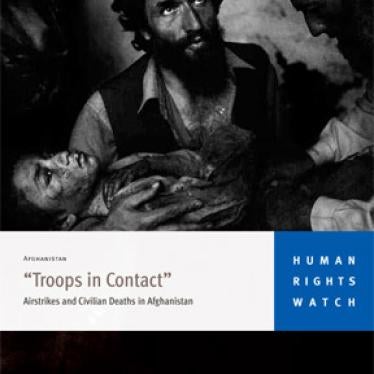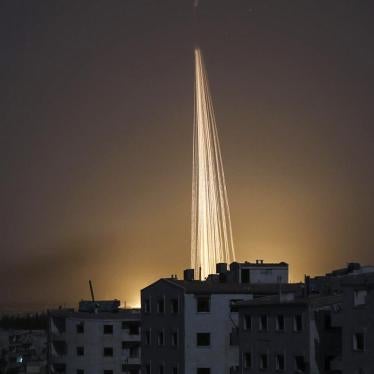(New York) - US and NATO forces should immediately agree to investigate any previously undisclosed civilian casualty incidents in Afghanistan revealed in US military documents leaked to the media on July 25, 2010, Human Rights Watch said today.
Initial media reports suggest that the roughly 90,000 leaked documents contain incidents of civilian deaths and injuries during combat operations that previously were not publicly acknowledged by US or NATO forces. Human Rights Watch's preliminary analysis of the data in incidents the organization previously investigated indicates that the US underreported civilian casualties by US and NATO forces because of incorrect information in after-action reports, and was very slow to correct the information.
"The leaked documents show that US and NATO officials should not rely on initial civilian casualty reports," said Rachel Reid, Afghanistan researcher at Human Rights Watch. "A commitment to investigate civilian casualties is only meaningful if early mistakes in the field are corrected and do not become part of the official reporting."
Leaked documents concerning incidents examined by Human Rights Watch in Afghanistan show how inaccuracies in the military's fact-gathering affected their public reporting of civilian casualties. US and NATO officials may have relied on these kinds of "spot reports" contained in the leaked documents - battlefield reports from low-level commanders in the field - to dismiss more accurate reporting of civilian casualties. After an August 2008 airstrike in Azizabad, Herat province, the US and NATO initially reported that only five to seven civilians were killed, a figure that was included in spot reports among the leaked data. The US and NATO publicly rejected separate investigations conducted by the United Nations, the Afghan government, and the Afghan Independent Human Rights Commission, which concluded that 78 to 92 civilians had been killed at Azizabad, the majority of them women and children. Only later did the US revise its initial estimate to say that 33 civilians were killed, which Human Rights Watch still considers to be an underestimate.
In Azizabad, the US had also claimed that the airstrikes had killed a military target, a Taliban commander named Mullah Sadiq. Human Rights Watch's analysis of the leaked documents found several references to a Taliban commander named Mullah Sadiq operating in that region in the months after the attack, including October, November, and December 2008. Human Rights Watch has previously called upon the US secretary of defense, Robert Gates, to release the classified investigation findings into this incident, including what was known about the whereabouts of Mullah Sadiq.
"The leaked data highlights again the tragedy of the Azizabad bombing but shows that many questions remain unanswered," said Reid. "The need for investigations into this incident and others is evident."
In another incident, the US military spot reports said that civilians were only wounded during an exchange of fire and sustained aerial bombardment in Bala Baluk, Farah province in May 2009. Once again initial US public statements on the incident downplayed civilian casualties, and later dismissed reports from the United Nations and Afghanistan Independent Human Rights Commission that 80 civilians were killed. Only weeks later did US investigators conclude that more than 26 civilians may have been killed.
In response to growing concern over civilian casualties, US and NATO forces announced a number of changes in operational guidance, including to "tactical directives" to forces in the field, in September 2008, December 2008, July 2009, and January 2010. Human Rights Watch welcomed these changes, which in order to reduce civilian casualties set higher bars for the use of air attacks and so-called night raids, call for transparent and immediate investigations when civilians are harmed, and provide that media statements refrain from denials of civilian casualties prior to investigations. The directives appear to have resulted in some reduction in civilian casualties caused by airstrikes in 2009 and 2010, though significant civilian deaths from air attacks continue and the use of night raids has risen with an increase in troops.
The US and NATO have suggested that concerns raised in the leaked documents, which go up to December 2009, have been addressed by recent operational changes. However, Human Rights Watch has found that the US in some instances continues to flout the September 2008 guidance that it transparently investigate civilian casualty incidents. Human Rights Watch investigated a May 2010 civilian casualty incident in Nangarhar province in eastern Afghanistan, in which nine civilians were killed during a night raid by US forces. The US has to date failed to investigate this case, and rejects claims by the families and Afghan government officials that civilians were killed. Two men were detained for five days after the raid, but were released without being questioned. The spokesman for US forces in Afghanistan, Col. Wayne Shanks, told Human Rights Watch on July 26 that a Taliban sub-commander called Mullah Shamsuddin was killed in the raid. Gen. Mohammad Mirza Yarmand, head of the Criminal Intelligence Department of the Afghan Minister of Interior, who led the government investigation, told Human Rights Watch what local residents had previously said that the US forces probably mistook Mullah Shamsuddin for a student named Shamsurrahman who was killed in the raid. Human Rights Watch urged US forces to immediately carry out a full and transparent investigation into this incident.
"Ignoring the protests of the families of the dead and the Afghan government only compounds the outrage that Afghans feel when civilians are killed," said Reid. "US forces should investigate incidents of civilian casualties, and, if wrongdoing is found, hold all those responsible accountable."
The leaked data also show that the vast number of civilian casualty incidents were caused by the Taliban and other insurgent groups. United Nations investigations show that in 2009 "anti-government elements" were responsible for the deaths of two-thirds of the civilians killed, 1630 out of a total of 2412. Human Rights Watch has long criticized the Taliban and other insurgent groups for conducting intentional and indiscriminate attacks against civilians and using civilians as human shields in violation of the laws of war.







